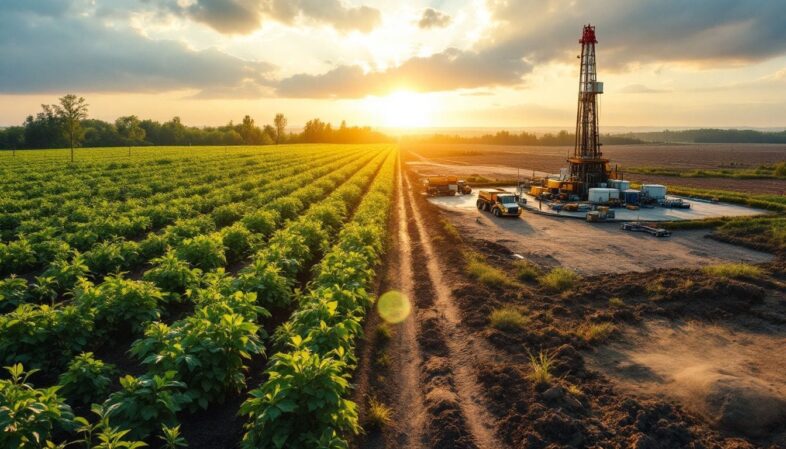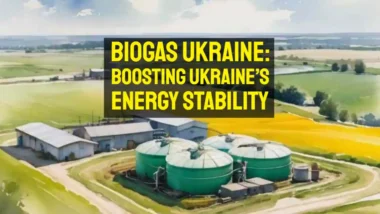Analysis of the Environmental Impact of Biogas Versus Natural Gas
Choosing between biogas and natural gas is vital for our planet. Both are used to generate electricity, cook, and heat homes but affect our world differently. Biogas is a renewable energy source made from organic waste, like food scraps and animal manure. 1 Natural gas is a fossil fuel found deep in the Earth. It's not renewable. 3
One key fact is that burning natural gas releases more carbon dioxide than biogas. This blog will explore how choosing biogas over natural gas helps fight climate change. We'll see why biogas is better for the earth. 2
Read on to learn more.
Key Takeaways
- Biogas is made from organic waste and is a renewable source of energy. It has low carbon emissions because it uses food scraps, farm waste, and animal manure.
- Natural gas comes from under the ground and is not renewable. Burning natural gas releases a whole lot more carbon dioxide (CO2) into the air than biogas does. This adds to climate change.
- Making biogas traps methane that would otherwise escape into the air. Methane is a strong greenhouse gas, so stopping it helps fight global warming.
- Using biogas creates a clean form of energy called biomethane. This can replace natural gas for heating homes and making electricity with less harm to the world.
- Natural gas drilling damages land and water resources. It also leaks methane during its production which harms our planet more than CO2 in some ways.
Understanding Biogas, Biomethane and Natural Gas

Biogas comes from organic waste, breaking down without air to make energy. Biomethane is clean biogas, while natural gas comes from deep in the earth.

Definition of Biogas
Biogas comes from breaking down organic matter without oxygen. This process, called anaerobic digestion, happens in special tanks. The main parts of biogas are methane (45% to 75%) and CO2, with some other small gases mixed in. 1 People use crop leftovers, animal dung, thrown away food, and sewage sludge to make it. In places like Europe, China, and America almost all the world's biogas is made. 1
Biogas turns waste into clean energy. It's a smart way to tackle trash and climate change at once.
Definition of Biomethane
Biomethane is clean fuel made from biogas. To get biomethane, we remove carbon dioxide and dirt from biogas. This process makes biomethane purer in methane than biogas itself. 2 People use it instead of natural gas because it's far less damaging as a climate changing gas.
It's also cleaner than oil-based fuels, meaning it gives lower polluting emissions when burnt. 3 Biomethane comes mostly from waste materials, making it a good choice for the environment.
Definition of Natural Gas
Natural gas is a type of fossil fuel found in natural geologically formed underground reservoirs. 3 It comes from the remains of ancient plants and animals, making it a non-renewable energy source. Extracting natural gas causes significant carbon emissions.
Moreover, methane leaks during its production and distribution add to its overall carbon footprint, making it less eco-friendly.
Key Differences Between Biogas, Biomethane, and Natural Gas
Biogas comes from organic waste, while natural gas is from deep underground. The way we make them is also different – biogas needs special tanks to break down the waste, and getting natural gas involves drilling into the earth.

Source and Composition
Biogas comes from organic waste, like food scraps and farm leftovers. Tiny living things break this waste down in the absence of oxygen, making biogas. It's mainly methane and carbon dioxide.
Biomethane is just the methane part of biogas. Biogas also has carbon dioxide, and other gases at lower percentages in it. We clean it (also called “upgrading”) to use as fuel. 3
Natural gas forms deep under Earth over millions of years, from old plants and animals. It's purer methane too but still comes out with some other gases that we need to remove before use.
While both come from different sources, they can end up so similar after processing that they are “equivalent fuels” and interchangeable. 4
Production Process
Biogas production starts with anaerobic digestion (AD). This process happens in biodigesters (digestion tanks). Microorganisms break down wet biomass, like food waste and agricultural waste. They thrive without oxygen. That's an essential requirement for generating biogas. 6
Upgrading biogas turns it into biomethane. Upgrading methods include amine washing and membrane separation. These processes enhance the gas quality to meet natural gas standards. The result is a cleaner fuel that can replace conventional natural gas in various applications, such as electricity generation and heating systems. 5
Environmental Impact of Biogas Production and Use
The production and use of biogas can cut down greenhouse gas emissions. It turns waste into energy, helping to fight climate change while reducing what goes to landfills.

Reduction in Greenhouse Gas Emissions
Biogas and biomethane can reduce greenhouse gas (GHG) emissions by 51-70% when compared to natural gas. 7 They use waste and organic material as feedstock, which helps mitigate climate change.
Biogas production generates less carbon dioxide than fossil fuels. This energy source reduces GHG but also captures methane that would otherwise escape into the atmosphere.
Utilising biowaste for biogas is a step towards sustainable energy. It promotes efficient waste management while providing clean power. Overall, transitioning to these renewable sources supports decarbonisation efforts and contributes positively to the environment.
Biogas as a Form of Energy from Waste (EfW)
Biogas serves as a key form of energy from waste. If used instead of allowing it to sit in open farm slurry lagoons it captures methane that would otherwise escape. Methane, is a very potent greenhouse gas.
Biogas is also emitted from landfills. If collected from landfills and burnt and used as energy from waste this reduces harmful emissions from landfills. 8
By processing biodegradable waste like food scraps and sewage sludge in anaerobic digesters, biogas plants produce this renewable energy source.
The process also yields digestate, which is a nutrient-rich fertiliser. 8 This reduces the need for chemical fertilisers in agriculture. Biogas can be upgraded to biomethane for heating or electricity generation, making it a versatile energy resource that supports sustainability and climate change mitigation efforts.
Environmental Impact of Natural Gas
Natural gas can harm the environment. It releases greenhouse gases, which contribute to global warming. This affects air quality and health. Gas extraction can also damage land and water resources.
Emission of Greenhouse Gases
Natural gas combustion releases large amounts of CO2. This contributes to global warming. In 2021, leaks from natural gas systems caused about 33% of total U.S. methane emissions. Methane is a powerful greenhouse gas.
Its impact on climate is 28-36 times greater than that of CO2 over a century. 9
Gas extraction and transport also lead to significant methane emissions. These processes can harm air quality and contribute to climate change. Reducing these emissions is vital for decarbonising efforts in the energy sector and mitigating climate change effects related to fossil fuels like natural gas. 4
Impact on Land and Water Resources
Natural gas extraction has serious impacts on land and water resources. The process involves deep earth drilling, which can disturb vast areas of land. This land disturbance disrupts local ecosystems and habitats.
Hydraulic fracturing, used in around 80% of US natural gas extraction, consumes large amounts of water. It also risks chemical contamination of water supplies.
This can lead to dangerous effects on both wildlife and human health. Over time, the depletion of natural gas is estimated to occur in about 52 years (MAHB estimate). 9 Such finite resources raise concerns for sustainable energy production.
Therefore, as we consider energy sources like biogas versus natural gas, understanding these environmental costs is crucial. 10
Comparative Analysis of Carbon Footprints
Carbon footprints vary widely among biogas, biomethane, and natural gas. Biogas has a lower carbon output due to its renewable nature and use of waste materials. In contrast, natural gas emits more greenhouse gases, impacting our planet.
Each source plays a role in the energy mix, influencing climate change efforts as we strive for cleaner alternatives.
Carbon Emissions from Biogas
Biogas has low carbon emissions. The CO2 released during its combustion equals the CO2 absorbed by organic matter while growing. 4 This process links biogas to a near carbon-neutral cycle tied to photosynthesis.
On a life cycle basis, biogas production can achieve over 90% reduction in emissions compared to natural gas. By recycling waste and preventing methane release into the atmosphere, renewable biogas plays a key role in mitigating climate change.
It utilises organic materials from farms, landfills, and wastewater treatment plants effectively for energy production.
Carbon Emissions from Biomethane
Biomethane has lower carbon emissions compared to natural gas. 7 Studies show that biomethane supply chains save between 42% and 65% of greenhouse gas (GHG) emissions compared to hydrogen production methods. 11 Methane is a potent greenhouse gas, so it generates some emissions during its lifecycle.
However, the overall impact of biomethane on the environment is positive due to its renewable nature. It helps turn waste into energy and reduces reliance on non-renewable resources.
This makes biomethane an important player in reducing GHGs while promoting sustainable practices in energy production from municipal wastewater and agricultural residues. Now, let's look at the environmental impact of natural gas.
Carbon Emissions from Natural Gas
Natural gas is a non-renewable fossil fuel. It contributes to greenhouse gas emissions. 3 Extraction and transport can cause methane leaks. These leaks increase its overall carbon footprint, making it worse for the environment.
Burning natural gas produces fewer emissions than coal or oil. It causes less air pollution and has lower carbon dioxide (CO2) emissions. However, the methane released during production still impacts climate change.
As a result, understanding these carbon emissions is key for waste management professionals and government officials in planning clean energy strategies.
Advantages and Disadvantages
Biogas has clear benefits, like using waste and cutting greenhouse gases. But it also has downsides, such as production costs and limited infrastructure. Natural gas is convenient, but it releases emissions that can harm our environment.
Each option comes with its pros and cons… so read on to explore more about their impacts!
Benefits of Biogas
Biogas offers many benefits. It is a renewable energy source that helps reduce waste. This energy comes mostly from agricultural manure, sewage, and municipal waste. 12 The process breaks down these materials effectively.
As a result, it generates high-quality natural fertiliser as a byproduct.
Using biogas lowers greenhouse gas emissions. It captures methane that would otherwise escape into the air. 10 Biogas production also supports waste management practices like composting and biomass gasification.
These methods contribute to carbon neutrality goals by recycling waste into energy and reducing landfill use.
Drawbacks of Biogas
Raw biogas has several drawbacks. It contains impurities like carbon dioxide (CO2), hydrogen sulphide (H2S), siloxanes, and nitrogen oxides (NOx). These can harm health and the environment. 13 High CO2 levels reduce the economic value of biogas. H2S is corrosive and can damage infrastructure. This gas poses serious health risks, including respiratory diseases.
Biogas production also faces challenges in waste management. Not all organic waste is suitable for digestion. The process requires careful selection of feedstocks to optimise results.
This makes it in some ways less efficient to produce compared to other renewable fuels like biodiesel or bioethanol. 14
Benefits of Natural Gas
Natural gas is an efficient energy source. It generates electricity and heat well, due to its high calorific value. 15 Using natural gas can help reduce reliance on more polluting fuels like coal.
This support makes it a transition fuel for future cleaner options.
Natural gas also can provide energy security for nations that possess their own gas fields. It diversifies supply sources for all countries that use it, offering flexibility in energy production. 15 In many cases, it produces lower greenhouse gas emissions compared to coal and oil.
These factors make natural gas a valuable part of the shift towards sustainable life cycle assessment (LCA) where it replaces coal or oil. Next, we will examine the drawbacks of natural gas usage.
Drawbacks of Natural Gas
Natural gas has notable drawbacks. Its production and transportation can release large amounts of methane. 16 This is often called “fugitive gas”. Methane is a powerful greenhouse gas that contributes to climate change.
Land disturbance occurs during natural gas extraction, harming ecosystems. Water resources are at risk too. Hydraulic fracturing (fracking) uses significant water and may lead to chemical contamination.
Flaring excess natural gas creates carbon dioxide and other pollutants, which damage air quality. This practice is safer than venting methane but still harmful.
Overall, these issues highlight the environmental costs associated with relying on fossil fuels like natural gas…
Conclusion
Biogas and natural gas have different impacts on our planet. Biogas helps reduce greenhouse gases. It turns waste into energy, which is good for the environment. On the other hand, natural gas harms the earth by releasing carbon dioxide when burned.
Choosing biogas over natural gas can lead to cleaner air and a healthier world for everyone.
FAQs
1. How does biogas compare to natural gas in terms of environmental impact?
Biogas, a renewable energy source derived from energy crops, landfill and sewage gas, has a lower carbon footprint than natural gas. It's part of the carbon cycle – when it burns, it only releases the carbon dioxide that was absorbed during growth.
2. Can biogas be used as an alternative to natural gas?
Certainly! Biogas can be converted into renewable natural gas or green hydrogen through a number of processes. These low-carbon energy sources can replace traditional natural gas in combined heat and power systems.
3. Is there any financial incentive for using biogas?
Yes, feed-in tariffs are often available for those producing renewable electricity from biofuels such as biogas. This helps offset costs and makes these options more appealing compared to fossil fuel sources.
4. What is syngas and how does it relate to biogas?
Syngas is produced from solid biomass via thermal gasification. Like biogas, syngas is a form of biofuel which contributes less GHG emissions than traditional sources of energy.
5. Can using biogas lead to negative carbon emissions?
In some cases – yes! When we use waste materials like landfill or sewage gases instead of letting them escape into the atmosphere directly, this process could potentially become carbon-negative. Meaning we're taking more greenhouse gases out than we're putting in.
References
- ^ https://www.iea.org/reports/outlook-for-biogas-and-biomethane-prospects-for-organic-growth/an-introduction-to-biogas-and-biomethane
- ^ https://blog.anaerobic-digestion.com/biomethane-vs-biogas/ (2023-11-25)
- ^ https://blog.anaerobic-digestion.com/biomethane-versus-natural-gas/ (2024-04-17)
- ^ https://valorify.com.au/biogas-vs-natural-gas-understanding-the-environmental-impact/
- ^ https://www.sciencedirect.com/science/article/pii/S0959652624033857
- ^ https://www.ieabioenergy.com/wp-content/uploads/2022/12/2022_12_12-IEA_Bioenergy_position-paper_Final2.pdf
- ^ https://pubs.rsc.org/en/content/articlehtml/2024/ee/d3ee02516k
- ^ https://www.qedenv.com/markets-applications/biogas-and-biomethane/biogas-upgrading/the-environmental-impact-of-biogas/
- ^ https://www.tandfonline.com/doi/full/10.1080/10934529.2018.1459076
- ^ https://www.worldwildlife.org/blog-posts/is-biogas-a-green-energy-source
- ^ https://pubs.rsc.org/en/content/articlelanding/2024/ee/d3ee02516k
- ^ https://www.sciencedirect.com/science/article/pii/S2211715624002455
- ^ https://www.ncbi.nlm.nih.gov/pmc/articles/PMC9589174/
- ^ https://www.homebiogas.com/blog/advantages-and-disadvantages-of-biogas/?srsltid=AfmBOorJEkXbYnSRLxXaEB0-Cjp6C2Ideg93N4T-sRU9f1vGUWN4DFx0
- ^ https://www.powerup.at/knowledge/natural-gas/difference-biogas-natural-gas/
- ^ https://www.eia.gov/energyexplained/natural-gas/natural-gas-and-the-environment.php




